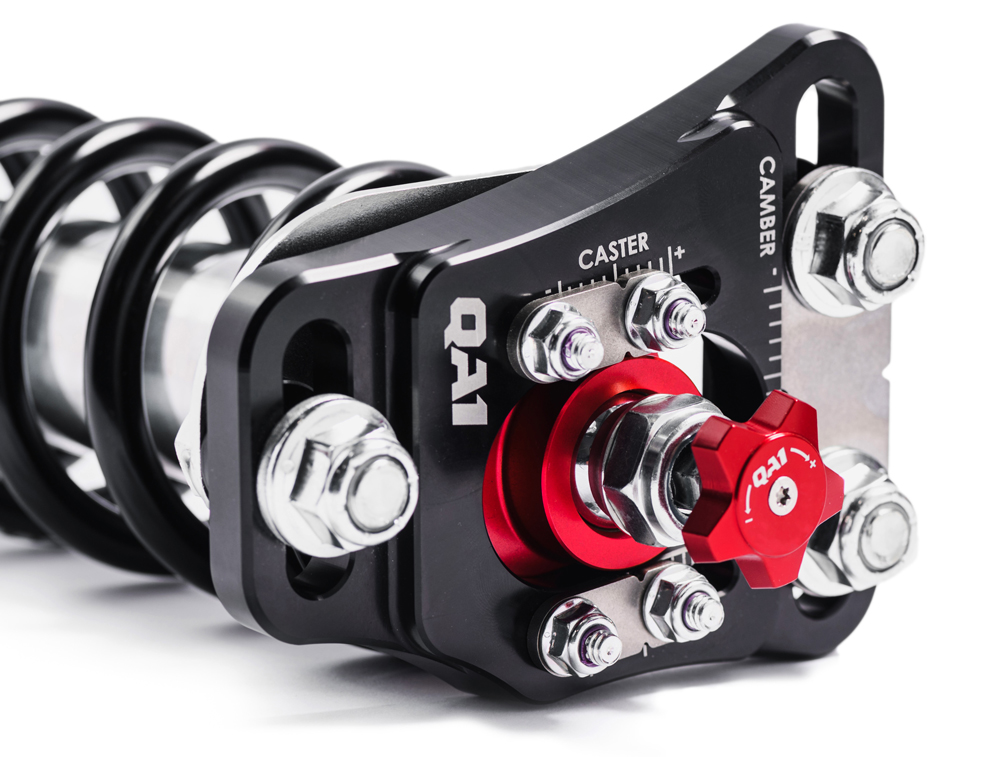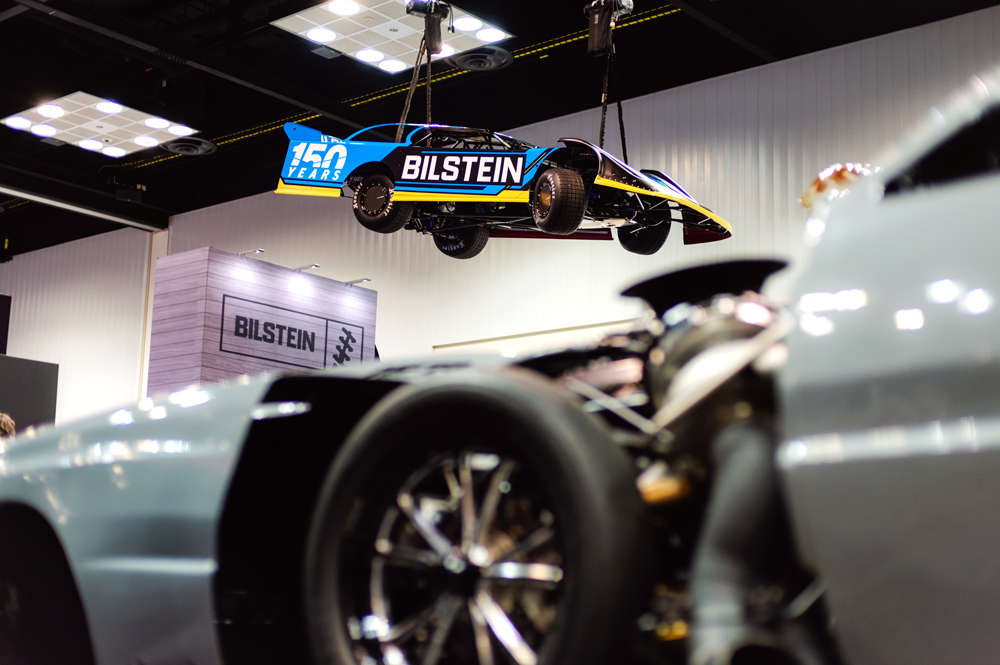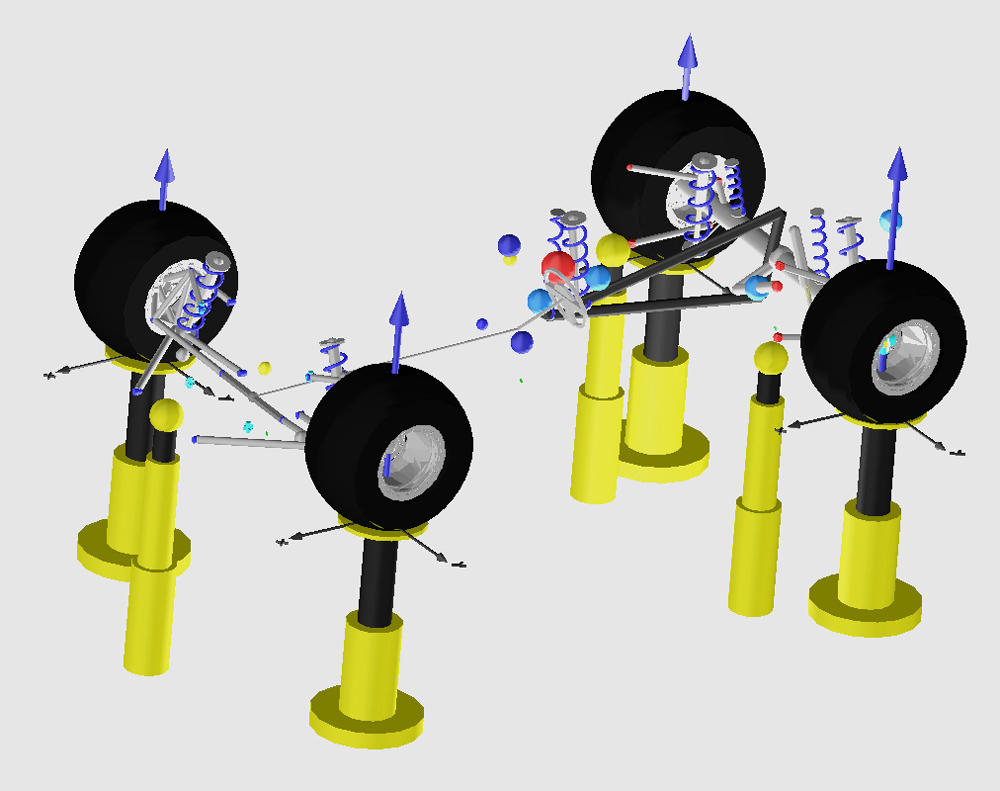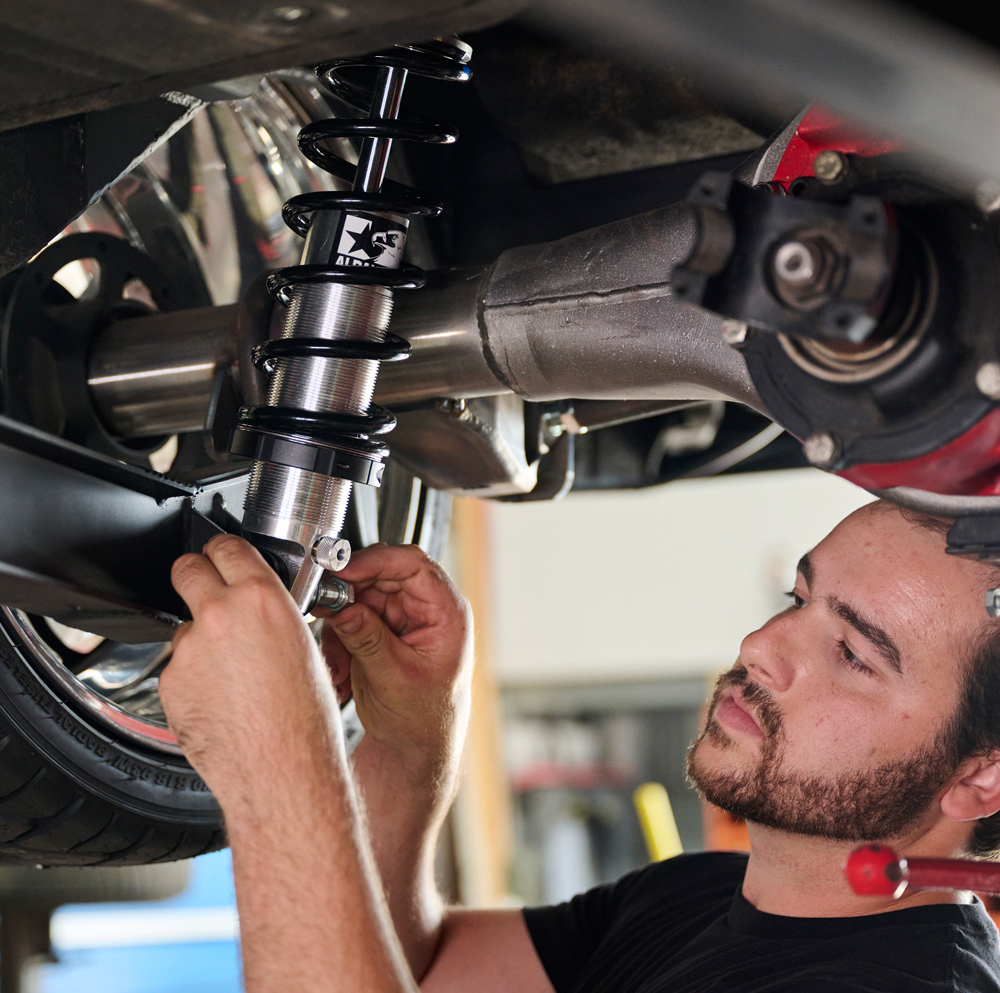Future Shock

Suspension manufacturers discuss new products, trends, and how shock and spring development are already moving into the future.
Racing drives innovation, the old saying goes. Except when it doesn’t. In the interrelated interests of parity and cost control, some sanctioning bodies impose limits on the components allowed on a race car, despite existing technology that could make the cars faster or more reliable. Probably the most famous example of this was NASCAR’s insistence on using carburetors long after the OEs phased them out in favor of fuel injection.
A similar situation is happening today with suspension systems. Electronically controlled active suspensions are becoming increasingly available in the transportation sector—and not just in the highest-end supercars—but a few sanctioning bodies allow them. “I think it was in the mid- to late-1990s when that was banned in Formula 1, and it’s carried over,” said Aaron Lambert of Penske Racing Shocks, Reading, Pennsylvania. “All the endurance-type sports car racing we’re dealing with has banned any type of active suspension whatsoever.”
“That’s all illegal in the circle track world,” added Ben Baker of AFCO Racing Products, Boonville, Indiana. There are other suspension limitations in dirt track racing, he added, pointing at the fallout from the rear suspension device engineered by Kevin Rumley and used by Jonathan Davenport on his dirt late model in 2015. “That basically allowed them to have a lot of extra droop in the car without a lot of steer,” Baker explained. “They won a lot of races with it, but rules came out later on and outlawed the part. It narrowed the box to play in, which I’m not a huge fan of. The late model world was supposed to help innovate.”
Yet despite sanctioning body rules—or more likely because of them—suspension manufacturers remain innovative, searching for the setup that will increase speed and shorten lap times. They’re using the advantage of electronics where allowed, and thinking out of the box when it comes to conventional spring and shock systems.
“Any time we try to develop shocks, you always have to look at the sanctioning bodies, what they do or don’t allow,” Lambert said. “Some series are sort of status quo, so the rules kind of stay where they’re at. There’s only so much development you can do inside that box. But then there are other series that are a little bit looser with the rules and allow you to develop. Those trends typically carry over to other similar series.”
Dirt Track Development
Attendees at the 2023 PRI Show saw a number of new products introduced by Bilstein Motorsport, whose American headquarters is in Poway, California. “Bilstein Motorsport displayed at the PRI Show with a singular objective: differentiation from competitors,” said Lexie Mead. “Our commitment to product development is centered upon dominance within our target market.”
To draw attention to the new gear, Bilstein hoisted a dirt late model car high over its booth. The car was fitted with Bilstein’s new AS2-R shocks, several versions of which were on display below. They included the AS2-R ESCV, built with an aluminum cannister and three-way adjustability, with high- and low-speed compression, and shaft-based rebound adjustments. “Notably setting this build apart, this shock incorporates an internal hydraulic bump stop,” said Mead. A Big Canister version of the AS2-R has, as its name suggests, a larger, 12-inch nitrogen canister, which allows lower nitrogen pressure with the increased nitrogen volume. There’s a new AS2 FSR that’s “uniquely designed to address the Northeast dirt modified market.” The AS3, a successor to the AS2, was designed for applications “catering to a twin-tube feel” and offering “zero rod pressure,” she said.

Not all the new Bilstein products were shocks; the company introduced a spring specific to the dirt late model market that’s “crafted for corner-specific applications” and is tailored to be used with Bilstein’s shocks.
Penske, too, has new shocks for this market, specifically designed for dirt modifieds. “Those cars used to have a steel shock rule, but now they’re opening up a little bit, and we have shocks for them with aluminum Heim ends,” Lambert said. That “doesn’t sound like a big thing,” he admitted, “but from a machining standpoint it makes it more cost effective for us to allow an aluminum body cap and aluminum eyelet.” Some modified series are also accepting single-adjustable shocks, Lambert said, “so that customer base, which was always locked into a non-adjustable shock and had to have multiple shocks to do one little change, now can have an adjustable shaft that gives them the freedom to do a little bit more fine tuning.” Penske is also adapting its NASCAR-style base valve into a steel shock, “which is going to work more efficiently and should feel better for the drivers and also should be better for tire wear.”
Lambert believes the modified classes “are allowing a little bit of freedom where they used to be really clamped down.” That may require “an uptick in spending” by the racers, “but the series are more competitive than they ever have been with car counts, the level of competition, and the payoffs. These races are paying out quite a bit more. So they’re allowing the racers to get a little bit—I don’t want to say free—but definitely allowing them to figure out some setups to be more competitive.”
Rising costs are on Penske’s radar. “We’re always conscious of what the racer is willing to spend,” Lambert added. “In the end, it has to make sense for the racers. I don’t like spending anybody’s money, so I want to make sure it’s worth it in value.” That’s why when it can, Penske will “take parts already available on the shelf and adapt them to what a current customer might already have.” The new adapter for the NASCAR base valve, for example, allows racers “to take their existing shocks and bolt those pieces right on. They don’t have to buy a whole new set of shocks.”

“The whole thing is a challenge,” acknowledged Steve Smith of QA1 Motorsports, Lakeville, Minnesota, “but we have to give the customer as much as we can, and still keep it within a price range that gives the part value.” Value, and performance tailored to local track conditions, were behind QA1’s introduction of the Dry Shock Six Pack last year.
“It’s very hard for us to have somebody call and ask about valving they should run at a certain track that we’ve never been to,” Smith explained. Plus, “racers will use different valvings on all four corners of a circle track car, and then it might sprinkle a little bit, and they want a whole different set of valvings.” The Dry Shock Six Pack is just as it sounds: a box with six dry shocks and all the components needed to set up track- or condition-specific valving. QA1 initially offered the Dry Shock Six Packs for front shock applications only, but it now offers the shocks in different lengths for both front and rear shock setups. Because they come six to a box, “a dealer can order a Six Pack and outfit a car and then have two differently valved backup shocks,” Smith said.
For AFCO, which also introduced new shocks at the PRI Show, the ideas for new products “come from the man in the field,” Baker said. “I do a lot of hand-to-hand testing with teams, who will say, ‘Hey, we need to be able to do this better.’ Maybe it’s a small modification to an existing part, or a whole new part altogether.”
One trend that Baker is wary of is the increasing number of teams “getting involved with pulldown rigs. I’ve seen some interesting innovations there, but I’ve also seen over-engineering there. You move things and you find different loads and think, ‘Oh, I’ve just got all kinds of traction.’ Then you go to the race track, and it’s totally the opposite. I do think pulldown rigs are a good thing to get the car through travel, check for bind, check for different things like that. But you’re not necessarily going to move a bar here and there and find tons of traction just because you found load on a scale.”
Drag Race Development
Baker said drag racing has recently become “a huge growing portion” of AFCO’s business. “Last year it may have even surpassed the circle track side as far as shocks were concerned.” AFCO has developed four-way adjustable shocks for drag cars, “and we’ve been working on different types of air shifters and controllers for them where you can change the valving in the shocks as you go down the track.” Most of the technical innovation, he feels, is originating in the Pro Stock and Pro Mod classes, “because that’s where most of the money’s at, and then it trickles down all the way back into the bracket racing classes.”
“The Pro Stock market is becoming heathier,” Lambert agreed, “so we’re constantly doing things there. Just small changes, as the engines become more efficient. The majority of those cars run some type of pneumatic adjustments that are all automatic based off the timers. So we are continuing to refine just how quickly the shocks can react to the track changes and to what the crew chiefs are looking at. Obviously, if you can get a little bit more mechanical grip to the rear tires, it makes a big difference.”

The no prep side of drag racing “is becoming more and more interesting,” he added, “and the shocks are becoming much more important. They have way more horsepower than they need, so whoever can figure out how to put more power to the ground usually does pretty well. We’ve been lucky to work with a few of those really good cars.”
“Drag racing has not been big for us before, but it’s becoming bigger now,” noted Erik Ras of JRZ Suspension Engineering, which is based in the Netherlands but has two service centers in Illinois. “A customer like Underground Racing, which builds those drag race Lamborghini Huracáns with 2,000 horsepower, they order suspensions from us which they can fine-tune to the extreme to control the squat of the car.” JRZ’s 50-DA system allows adjustment of the compression and rebound “directly on the piston, and that makes it a very sensitive system for drag racing.”
Road Racing & Autocross Development
Drag racing is just a part of the “very broad market” to where JRZ supplies suspension components, Ras said. Many of its customers are road racers, running their cars on courses as diverse as the Nürburgring and Pikes Peak. For them, JRZ offers products from two different lines, the RS line and the Motorsport line.
“All the shocks we manufacture are from the Motorsport production line,” Ras explained, “so in reality, those choosing the RS line are getting a motorsport shock they can use for racing as well.” The biggest difference between the two is their adjustability. Shocks in the Motorsport line offer “a slightly bigger adjustment range, and the steps in between are slightly smaller.” Also, “all the compression and rebound adjustments in the Motorsport shocks are 100% independent from each other, while with the RS line, the compression adjustment is also independent, but when you adjust the rebound, there’s a slight difference in compression damping as well.”
At the 2023 PRI Show, QA1 debuted new struts for Mustangs and third-generation Camaros. “We had struts previously, and they worked fine,” Smith said, “but there were some design changes we wanted to make.” Now part of the Proma Star line, the bodies are made from aluminum, “so there’s lots of weight savings.” Also, the new struts mount inverted, “so the majority of the weight of the strut is hanging on the upper mount, which allows 4 or 5 pounds of sprung weight to be saved, which is going to lead to faster suspension reaction times,” Smith said.

Along with the new struts, QA1 introduced new caster/camber plates for 1979–2014 Mustangs. “These are available in the single- and double-adjustable versions like we’ve always had,” Smith said. “But the adjustment knob for the compression and rebound is on top of the caster/camber plate. You don’t need to reach under or behind the wheel to make any adjustments.”
There are also new Mustang control arms from QA1 in both race and street versions. They have forged ball-joint housings integrated into the weldment, “so now the ball-joint housing is part of the arm,” Smith said. “You save weight without sacrificing any strength.” Both street and race versions have low-friction ball joints. “The big difference between the two is that in the race arms we have a cam eccentric in the mount with a hex on it, so you can get additional caster and camber adjustments out of that.”
Smith sees these new products as part of the evolution of race car parts. “Even if we have a product that does really well, we’re always looking for ways to manufacture it in a different way or add more benefits for the customers.” The inspiration for these changes comes from QA1 customers, he said. “We get weekly updates from our phone calls, and we get a lot of feedback from our customers. We take what we’re hearing and turn it into the product development side, and then we make decisions from there.”
Aldan American of Signal Hill, California, has “predominantly a hot rod and cruise night kind of customer base,” said Gary Nelson, but it does offer coilover systems for “the lower end drag race classes, the guys working on their cars in their garage. Our clientele is running the index classes, and they want something that’s consistent, that they can adjust for track conditions in order to run their ET.”
To serve those and its other customers, Aldan has expanded its offering of double-adjustable shocks. “And we’ve been doing a lot more direct-fit applications for a cruise-night car that goes autocrossing occasionally,” Nelson added. “With a set of double-adjustable coilovers you can have something pleasant to go to a cruise night, and with some twists of a couple knobs you can have a lot of fun on the autocross.” The direct-fit applications, which drop into the stock suspension locations, started with Vipers and C5/C6 Corvettes and have expanded into Mustangs, Camaros, Chevelles, and other American muscle and performance cars.
The Active Suspension Question
For those classes that allow it, JRZ has developed an active suspension system valve that is “extremely fast and extremely accurate,” Ras said. “There’s no hysteresis, which means when you take current away from the valve, there’s no remnant magnetism left in the coil. So the valve always goes to exactly the position you want the valve to go.”
Ras has racing customers using the active system on Pikes Peak to help mitigate the changing road conditions on the mountain. “The road surface can be completely different from the lower section to the upper section, so you want to have more control. With the active system, you can control it on the fly, and it will adjust to what it needs to do.”
Ras believes some time in the future, perhaps “five years from now, active suspension will be allowed because by then it will be commonly used in all the cars.” Resistance to it from the racing community isn’t a matter of cost, he believes, but because “it’s mostly unknown.”
Lambert sees two reasons to keep active suspension systems out of racing. “Being able to police that and enforce that gets a lot more difficult when you’re dealing with electronics.” He also sees cost as a barrier. “When it comes to racing, the low dollar [active suspension systems] never work as well as they need to. You can really spend a lot of money on very expensive valves and things like that to make an active suspension react the way you want it to.”
Mining Data
At the top tiers of racing, gathering suspension data through race simulation has become a necessity, Lambert said, “because they typically limit the amount of testing you can do.” He sees the practice trickling down into other race disciplines, and Penske is moving that way when it comes to its dirt late model racing customers. He acknowledged that testing for a dirt late model team isn’t as limited as in other series, “but the testing side has become so costly when you’re putting laps on your motors and on your tires and burning fuel.”
Penske is working with Claytex USA of Cornelius, North Carolina, in building a dirt late model simulation package. “We purchased our own dirt late model house car that we have on a pulldown rig in our shop in North Carolina. We’ve had that entire car scanned and put into our sim package.
“It’s quite an undertaking,” he added. “You have to have your chassis scanned and put in there, you have all your moving pieces put in there, we have the shocks themselves modeled, the spring curves modeled, you have to do the tires. But once you have it and you start correlating it to the real world, and you can start making your simulation match what you see on the race track, it really starts to streamline the process of developing new pieces and seeing what they do before you cut metal or bolt it on somebody’s car or ask a team to waste laps on tires and engines to see what it feels like.”
This would be a good time to clarify an important point. Nate Horn of Claytex said, “In the vehicle simulation world, a simulator is considered something that has a steering wheel and pedals. A desktop simulation, what we are doing here, is something that is run by the click of a mouse on a computer. The math model that is run in the desktop simulation (when properly implemented) is what runs in ‘real time’ on a powerful computer that is hooked up to a driving simulator.”
“You’ll be seeing a lot more about this in the next two to three years in these lower forms of racing,” Lambert predicted, “because in the end, it’s more cost effective to do it that way.” While Penske’s customers are going to benefit from what’s learned by the company’s simulations, “ultimately if you really want to refine it and make it your own, you have to scan your own chassis, because everything’s a little bit different. But right now, just in terms of general tuning and trends, we’re going to learn more because now we can run a simulated lap in a matter of seconds compared to waiting to go to the race track and trying different things.”
Sources
AFCO Racing Products
afcoracing.com
Aldan American
aldanamerican.com
Bilstein Motorsport
bilstein.com/en-us/
Claytex USA
claytex.com
JRZ Suspension Engineering
jrzsuspension.com
Penske Racing Shocks
penskeshocks.com
QA1
qa1.net
 MEMBERSHIP LOGIN
MEMBERSHIP LOGIN JOIN PRI
JOIN PRI


